My previous design experiences are arranged according to their artistic mediums in green categories below my current design project. To reveal more information about my previous design experiences, place your cursor on the accompanying text to the right of each visual artifact and scroll.
[current mission:] Undergraduate Creative Honors Thesis
To view more information about the artifacts featured in my thesis, place your cursor on the accompanying text below each graphic and scroll.
[thesis title:] From Pixels to Pleasure: How Black Modding is Pleasure Activism
[timeframe:] Mar 2023 — Jun 2024
[presentation link:] Here
[created using:] Photoshop, Blender, Premiere Pro, Figma, Canva, Google Docs
[advisors:] Michele Elam, Jennifer Stonaker, Helen Chen, Katie Dieter, Grace Toleque
[thesis summary:] This research study analyzes how Black modding reshapes digital spaces into personal sanctuaries for Blackness to fully manifest. Black modding is characterized by the intentional efforts made by Black video game players to change video game content, such as an avatar’s appearance and functionality, to cultivate a more pleasurable video gaming experience where Blackness is appreciated through detail and consideration. By integrating back into existence the Black aesthetics erased or unaccounted for in video game development, Black players modify their games to feel better about how Blackness exists in the digital worlds video games make accessible to them. This makes Black modding a liberatory act based on the reclamation of Black pleasure when framed by the larger fight for justice and liberation, which resonates with what adrienne maree brown calls “pleasure activism.” Black modding is a form of Black pleasure activism: it is a Black gamer’s reclamation of their whole, happy, and satisfiable Black selves in digital spaces. To frame this argument, I utilize three qualitative research methodologies and artistic methods to investigate the human–to-digital world connection as a dialectic of Black players confronting and choosing to counter erasure when playing video games, specifically in life simulators like The Sims.
[name of projects:] FULL STOP. MAGAZINE & TELLEM PODCAST
[podcast link:] Here [Music credit to MetzMusic on YouTube !]
[timeframe:] Sep 2023 — Jun 2024
[created using:] Photoshop, Blender, & Figma
[collaborators:] ItsMeTroi, SpringSims, and other Black Simmer Communities
[project description:] As a creative component to my thesis, I stylized my literature review into a magazine titled "FULL STOP." This Black digital humanities magazine is a call for all Black digital users to not only see, but reckon with the ways Black erasure—as a consequence of social politics and technological limitations—is confronted and combated by Black artists, artisans, and video game players who blend, color, and code back into existence the Black aesthetics oppression attempts to erase or make undesirable.
[design philosophy:] I recall the pivotal moment when my advisor encouraged me to expand my research horizons beyond "expected" scholarly articles and theory books. This liberating advice opened doors to new possibilities, reshaping my perception of what scholarship could look like. This moment prompted me to view design as more than aesthetics—design is a tool for immersion that can support academic inquiry by making theory palpable in ways that resonate. For this reason, I challenged myself to turn my "expected" literature review into something more. Reflecting on this experience, I realize that if I were to redo these covers, I would first familiarize myself with the composition of typical magazines before embarking on the stylization process. This approach would allow me to create a layout that effectively showcases the diverse content featured in each issue.
[personal reflection:] Black digital communities engage in artistic dialogues with the default settings of digital technology and media. They challenge the Internet and its supporting industries, such as Video Game Development, to embrace greater expansivenes, inclusivity, and cultural sensitivity. In light of this, I collaborated with these communities to celebrate how these artistic dialogues manifest—from video game character options to song requests. As part of this collaboration, submissions featuring Black avatars created using player-made attributes and characteristics were prominently featured and graphically edited by me. The opportunity to reach out to these communities and witness their enthusiasm for participating in my research was truly heartening.
[previous missions:] presentations
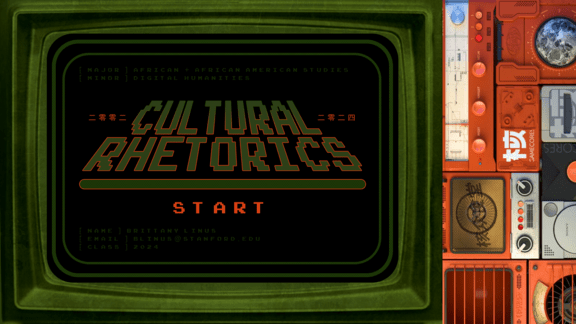
[project name:] My Cultural Rhetorics Commonplace Book
[link:] Here
[timeframe:] Jan — Mar 2024
[created using:] PhotoShop & Figma
[project description:] A personal anthology of cultural rhetorics literature that resonants with my academic exploration of Black digital expression.
[reflection:] The anthology explores cultural rhetorics as a means of deliberate affirmation by delving into the diverse ways in which different communities construct significance and meaningful interactions. In the realm of digital communication, cultural rhetorics serve as a lens through which to understand how various demographics engage with each other, digital platforms, and the broader internet landscape, employing distinct modes of rhetorical comprehension and expression. Within this collection, I employed visual rhetoric—a facet not extensively covered in my introductory cultural rhetorics course—to elucidate the concepts I deemed significant. Through this visual medium, I aimed to refine and enhance the clarity these concepts and ideas provided me as I design.
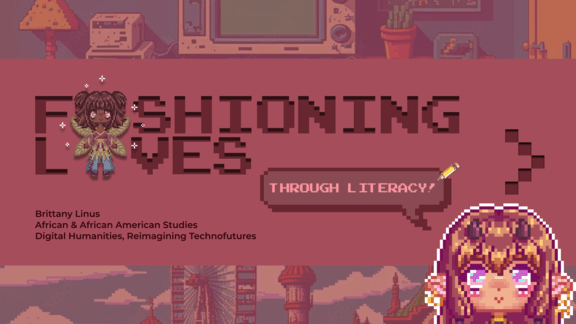
[project name:] Fashioning Lives Through Literacy
[link:] Here
[timeframe:] Jan — Mar 2024
[created using:] DeviantArt & Figma
[project description:] A presentation for the 2024 cohort for the introductory course in Cultural Rhetorics at Stanford University based on Eric Darnell Pritchard's seminal book, "Fashioning Lives: Black Queers and the Politics of Literacy."
[reflection:] As part of my collaborative teaching assignment, I embarked on a dynamic exploration of the final chapter of Pritchard's "Fashioning Lives," which delves into the nuanced concept of eroticizing undesirability through language reclamation. Tasked with leading a lecture and facilitating class discussion, I sought to infuse the session with interactive elements that would both engage and challenge my classmates. Embracing a visual rhetoric approach, I invited my peers to embark on a journey into the realm of visual language, exploring the implications of eroticizing undesirability through imagery. Central to this endeavor was a class activity designed to spark creativity and critical reflection: the moodboarding session. In this activity, participants were tasked with creating moodboards that embodied the essence of "undesirability" while simultaneously expressing their aesthetic desires. By juxtaposing these seemingly contradictory elements, we aimed to provoke deeper inquiry into the societal constructs of beauty and desirability, as well as the transformative power of visual representation. Through this collaborative exploration, we challenged traditional notions of attractiveness and delved into the complexities of desire, identity, and self-expression. By interrogating the visual language of desire and reclaiming agency over our own narratives, we embarked on a journey of self-discovery and empowerment.
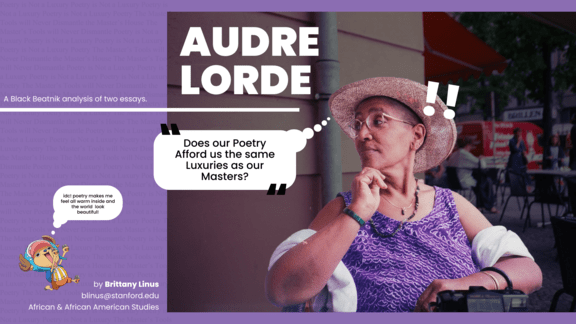
[project name:] A Black Beatnik Analysis of Two Essays written by Audre Lorde
[link:] Here
[timeframe:] Sep — Dec 2023
[created using:] Figma
[project description:] A presentation on Audre Lorde's essays "The Master's Tools Will Never Dismantle the Master's House" and "Poetry is not a Luxury" analyzing how Black feminst paradigms align with Beat spirituality and Keroucian modalities of expression.
[reflection:] This presentation marks my inaugural foray into analytical discourse, aiming to unravel the intricate relationship between Black American literature and the prevailing white subcultural themes of the same era. At its core, the narrative is anchored by a timeline that juxtaposes the emergence of the Beat generation with significant milestones in Black social movements, illuminating not only temporal overlaps but also the deeply intertwined personal connections between Black writers and their Beat counterparts. A central thread in this exploration is the profound friendship between Audre Lorde and Diane di Prima, emblematic figures whose bond exemplifies the convergence of Black and Beat sensibilities. By mapping their relationship alongside broader cultural movements, I aim to reveal the symbiotic influence and cross-pollination of ideas between these distinct yet interconnected literary spheres. To enrich this analytical narrative, I draw parallels between the ethos of Blackness, the countercultural spirit of the Beats, and the contemporary resonance found in unexpected cultural artifacts, such as the One-Piece manga. Through a multidimensional lens, I explore how the ideas articulated by Lorde and echoed by Beat writers find resonance and reinterpretation in diverse cultural expressions, transcending traditional genre boundaries. Ultimately, this endeavor seeks to illuminate the fluidity and interconnectedness of literary and cultural movements, inviting audiences to engage with a rich tapestry of ideas that transcend conventional boundaries of race, culture, and genre.

[project name:] From Pixels to Pleasure: How Black Modding is Pleasure Activism
[timeframe:] Jun — Dec 2023
[created using:] Photoshop, Blender, & Figma
[project description:] A pitch presentation on Brittany Linus' thesis: How Black Modding is Pleasure Activism. This creative honors thesis is created in collaboration with the Department of African and African American Studies and the Institue for the Diversity in the Arts. A special thanks is extended to Bings Honors College for inviting me to partiicpate as a residential student for their thesis intensive for the 2023-2024 academic year.
[reflection:] To bolster my creative honors thesis, I participated in a thesis writing intensive tailored for honors students in African and African American studies during my senior year at Stanford University. Within this program, I crafted a thesis pitch aimed at offering a comprehensive overview of my thesis's essence, the artistic methodologies I'm employing to investigate it, and an exploration of the ethical considerations and limitations inherent in my chosen approaches. Central to my thesis pitch is the examination of digital media, primarily visual, and its impact on Black users. Through strategic utilization of blank space and juxtaposition, I sought to prompt viewers to contemplate the constraints surrounding customization options for Black users while also showcasing how Black modding serves as a means to transcend these limitations. In future iterations of this presentation, I intend to integrate updated versions of my artistic methods. This includes stylizing my literature review as a fashion magazine, as well as incorporating time-lapsed videos depicting the process of Black modding. These enhancements will provide viewers with a clearer understanding of Black modding and its significance as a tool for enabling Black identity to thrive within digital spaces.
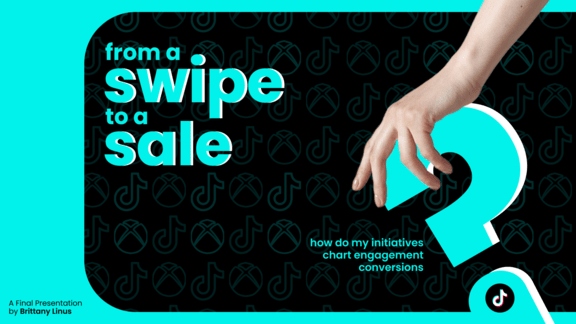
[project name:] From a Swipe to a Sale
[timeframe:] Jun — Sep 2023
[project description:] A final presentation I delivered to my team at TikTok as a Global Business Solutions Sales Intern. In this presentation, I provided a comprehensive review on all of the campaigns, measurement studies, data visualization projects, and process optimizations I led or contributed to during my internship. I began by outlining the objectives and scope of each project, detailing the methodologies used, and presenting the key findings and insights generated.
[reflection:] In my final presentation, I provided an in-depth overview of my diverse role within TikTok. Throughout the presentation, I underscored the various initiatives I spearheaded to optimize performance and streamline processes for our partnered brands. One key aspect I highlighted was the development of automated reporting systems tailored to the specific needs of our partnered brands. These systems enabled real-time monitoring of campaign performance and provided invaluable insights for our partners to make data-driven decisions. Additionally, I showcased the performance charts I designed to offer real-time insights into the effectiveness of our Always-On campaigns across different markets worldwide. These charts not only provided a comprehensive overview of campaign performance but also facilitated quick and informed decision-making. Furthermore, I discussed my role in creating a scorecard specifically for Xbox, which proved instrumental in streamlining performance metrics and assessing the success of market expansion initiatives. This scorecard served as a valuable tool for evaluating the impact of our campaigns and identifying areas for improvement. Throughout my internship, I emphasized my dedication to data-driven decision-making and highlighted how my analysis of campaign performance and brand insights contributed to the success of various initiatives. By combining my analytical skills with my design expertise, I was able to generate actionable insights and drive results for TikTok and our partnered brands.
[previous missions:] virtual exhibitions
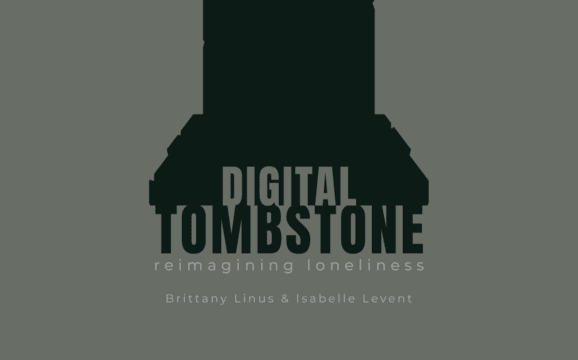
[project name:] Digital Tombstone: Reimagining Loneliness
[collaborator:] Isabelle Levent
[link:] Here
[timeframe:] Sep — Dec 2022
[created using:] Digication & Figma
[project description:] Chosen to collaborate with Stanford University's Design School (d.school) as part of the 2022-2023 cohort of Forbidden Designers, we embarked on a journey to explore the transformation of once-forbidden innovations into significant drivers of change in both the marketplace and human experiences. Our focus centered on the role of design in navigating the complexities of death and marriage politics and culture. Our exploration culminated in a final forum hosted in the d.school atrium. Here, Isabelle and I conceived a unique installation: the memory booth. This interactive space provided participants with a platform to reflect on the concept of digital death and to create digital tombstones in memory of their departed loved ones. The poignant recordings captured within this booth are now showcased on a virtual exhibition website that I spearheaded. This platform serves as a testament to our collective journey of discovery and reflection, highlighting the evolving landscape of design's responsibility amidst the intricate webs of life and loss.
[reflection:] During our participation in the 2022-2023 cohort of Forbidden Designers, Isabelle and I uncovered a crucial oversight in our coursework and research on design innovations within the realms of death and marriage: the neglect of digital interactions within these spaces. This realization became the catalyst for our final forum ritual, where we sought to bridge the gap between the physical and digital worlds. Inspired by this limitation, Isabelle conceptualized a poignant addition to our forum: the memory booth. Here, participants were offered a private space for contemplation, allowing them to reflect on personal experiences with death while also having the option to record their last thoughts for loved ones who had passed away. Drawing from these recordings, I undertook the creation of a virtual archive, providing a lasting repository for these intimate reflections. As our project evolved, I expanded the website beyond a mere storage platform for audio recordings. Infographics were incorporated, shedding light on the broader context of digital death—the political and cultural implications surrounding it. This addition not only enriched the participant experience but also served as a critical reflection on the purpose and significance of our final forum. Through this project, I came to appreciate the potential of digital components to augment in-person experiences, acting as reflective extensions that deepen engagement and understanding. Our journey at Forbidden Designers not only nurtured critical thinking but also instilled in us a sense of creativity and empathy, propelling us to explore complex and meaningful topics with depth and sensitivity.
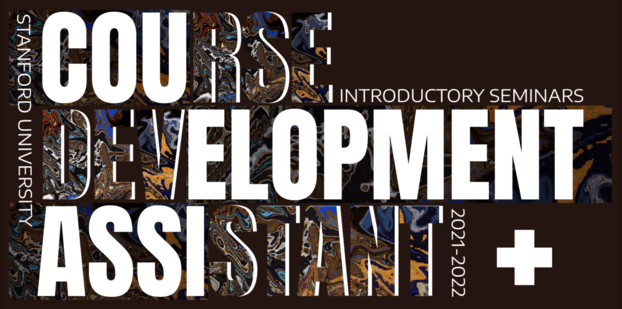
[project name:] What is a CDA+?
[timeframe:] Sep 2021 — Sep 2022
[created using:] Digication & Figma
[project description:] A virtual exhibition in which I capture the guiding principles and methodologies behind my tenture as a Course Development Assistant+ in Stanford University's Introductory Seminars Program. My specialities not only are based in hybrid-clasroom lesson-planning, but assisting teaching staff in revitalizing course material and culture (coordinating field trips, reserving labs for observations, including memes in anouncements etc.)
[reflection:] Creating this ePortfolio was bittersweet for it represents the end of my position as a Course Development Assistant+. Featured in this exhibition is my approaches to not only lesson-planning, but building rapport amongst the students enrolled in the courses I oversaw. I would have included pictures of the student cohorts I oversaw, however I did not have these student sign a public release nor consent form, so I opted to showcase how I built rapport with my students through my use of structural components, such as communication channels and website formatting.
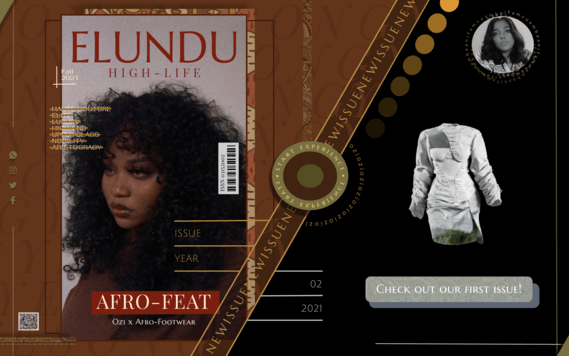
[project name:] ELUNDU: The Highlife Fashion Magazine
[link:] Here
[timeframe:] Sep — Dec 2021
[created using:] Figma, Blender, & Photoshop
[project description:] A stylized virtual exhibition of the Songye sandals——a set of wooden sandals featured in Stanford University's African Collections——as a fashion magazine to produce an interactive and paradigm unsettling experience of engagement with African history through contemporary methods; in this case, contrasting 20th century footwear trends with 21st century fashion advertisement styles (i.e. 3D renders, gifs).
[reflection:] Radical hesitation and juxtaposition where the guiding design principles I used to craft this exhibition. In American canon, Africa is viewed as a primitive state lacking ingenuity, so I leveraged contemporary methods of advertisement to dispell such notions when first interacting with this exhibition. Atferwards, I focused on including shoewear from African brands today that are similar in style to the Songye sandals. This inclusion was intentional to connect material mobility with style inspiration and socioeconomic trade relations. I fell in love with fashion as a dynamic archive through this project, in turn developing a deep-seated appreciation for handcraftsmanship I wanted to impart onto others in an interactive and engaging fashion. If I could redo this project again, I would focus on wireframing to build around the user experience, rather than creating a design and superimposing the user experience on it for a more user-friendly landing page.
[previous missions:] game design
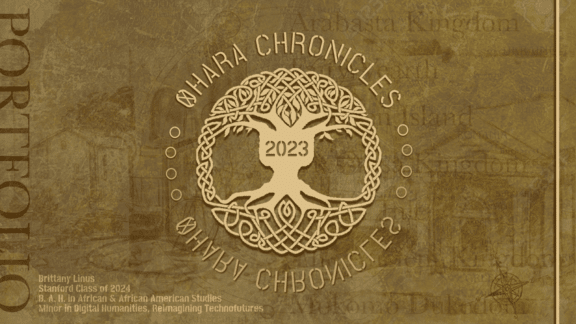
[project name:] Ohara Chronicles
[link:] Here
[timeframe:] Sep — Dec 2023
[created using:] Photoshop, Premiere Pro, & Figma
[project description:] An indie and pixel exploration game set in the world of One Piece. The Library of Ohara, a repository of knowledge housed within the colossal Tree of Knowledge. This tree——alongside the scholars housed in it——was burned to the ground by the World Government to conceal all research and historical records preserved there. However, this game presents a speculative twist: What if the library did not burn?
[reflection:] Developing Ohara Chronicles from its initial elevator pitch to its current state is marked by thoughtful considerations and constructive feedback. The initial pitch envisioned an indie and pixel exploration game set in the expansive world of One Piece, with players taking on the role of archivists exploring the Island of Ohara. The cyclical gameplay, alternating between exploration and archiving, aimed to create a rich historical timeline within the One Piece universe. The feedback rightly pointed out concerns about the learning curve, especially for new players unfamiliar with the One Piece canon. Recognizing the need for an accessible onboarding process to ease players into the One Piece storyline is a strategic move to help players understand where the video game is set. This ensures that both seasoned fans and newcomers can enjoy the game, striking a balance between complexity and approachability. Here, cinematic cutaways serve as important narrative tools to provide context for newcomers interested in the game, but unfamiliar with the source material. This portfolio also includes a a sonic map to further
[previous missions:] logos
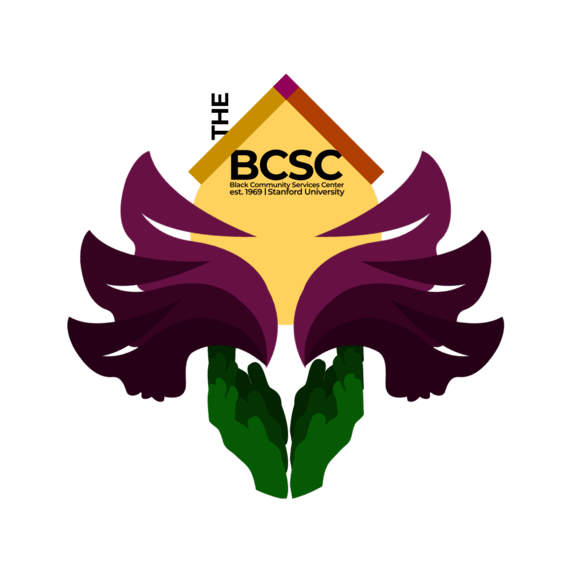
[project name:] Blossom
[timeframe:] Aug — Sep 2023
[created using:] Figma
[project description:] Logo submission to Stanford University's Black Community Services Center for the 2023-2024 academic year in which the theme, "For us. By us. Through us," is signified as a blossoming flower.
[reflection:] After embracing a challenge from the Black Community's Services Center (BCSC) at Stanford University to craft a logo reflective of their theme for the 2023-2024 academic year, "For Us By Us Through Us," I conceived "Blossom." This emblematic creation marries simplicity with symbolism, employing basic shapes and harmonious colors reminiscent of the BCSC logo itself. "Blossom" embodies a subtle, yet profound intertwining of elements: within its design, the contours of petals and stem seamlessly morph into side-profile faces and clasped hands, ingeniously incorporating the essence of community and solidarity. This amalgamation not only evokes the BCSC's ethos, but also encapsulates the spirit of unity, resilience, and growth intrinsic to the Black community. The motif of a flower resonates deeply with the BCSC theme, symbolizing not only beauty and vitality but also the transformative power of collective action. "Blossom" serves as a visual testament to the enduring strength and interconnectedness of the Black community, illustrating how, through collaboration and empowerment, we can cultivate change and cultivate a brighter future—for us, by us, through us.
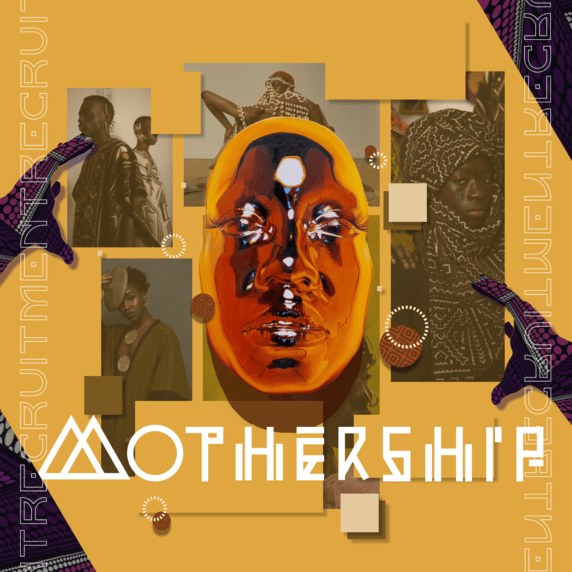
[project name:] MOTHERSHIP
[timeframe:] Sep — Dec 2021
[created using:] Photoshop & Figma
[project description:] A recruitment flyer for creatives at Stanford University to participate in a possible cultural showcases titled, "MOTHERSHIP."
[reflection:] In crafting a thematic concept for the African Student's Association at Stanford, I meticulously designed a recruitment flyer aimed at engaging all creatives, specifically Black African artists, to participate in our forthcoming cultural showcase. Embracing the ethos of Black exploration through artistry, I conceived the logo, "MOTHERSHIP," drawing inspiration from both space exploration and the rich tapestry of Black African heritage. Though the images comprising the logo are not of my own creation, this design endeavor enabled me to meticulously ensure congruency with our overarching theme. This project exemplifies my ability to synthesize diverse influences into a cohesive visual narrative and showcases my dedication to celebrating and amplifying Black African creativity within the Stanford community.
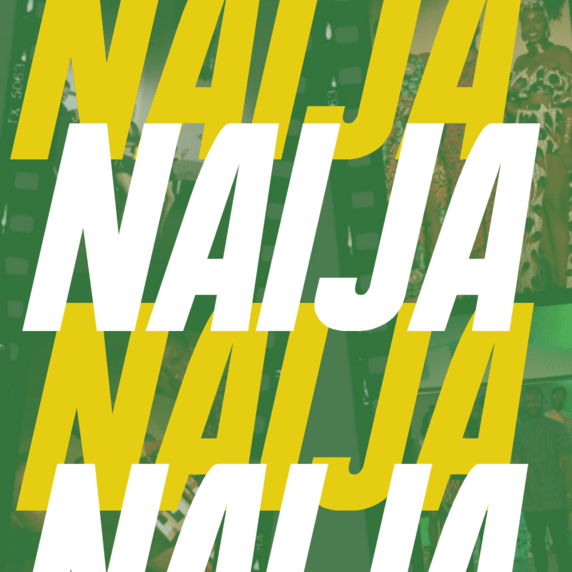
[project name:] NAIJA DEY
[timeframe:] Jun 2021 — Present
[created using:] Figma
[project description:] A logo for Stanford University's Nigerian Students' Association based on the following colors: green, white, and gold.
[reflection:] As the lead graphic designer for Stanford University's Nigerian Students' Association, I crafted this logo with the intention of rejuvenating our social media presence, drawing Nigerian students to our web platforms and exciting events open to both Nigerian students and the broader Stanford community. The logo incorporates a vibrant collage of photos capturing the essence of our cultural showcase, overlaid with a striking green tint, symbolizing growth, vitality, and the rich cultural heritage of Nigeria. This innovative design marks my first foray into collage-based graphic design, infusing the logo with dynamic energy and visual appeal. Emblazoned atop this captivating background is the association's name, "NAIJA," dynamically rendered with alternating hues of white and gold. This color scheme not only reflects the national colors of Nigeria but also conveys a sense of prestige, unity, and celebration. Through this visually compelling logo, we aim to establish a distinctive digital footprint that resonates with Nigerian students while also inviting engagement from the broader Stanford community, fostering a sense of inclusivity, pride, and cultural appreciation.
[previous missions:] posters
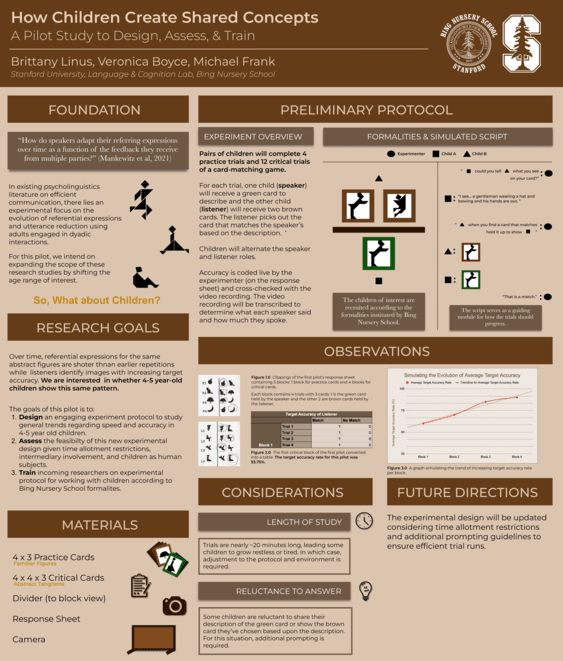
[project name:] How Children Create Shared Concepts
[link:] Here
[timeframe:] Jun — Oct 2022
[created using:] Figma & Github
[project description:] As a Symbolic Systems research assistant for the Language Cognition lab at Stanford University, I collaborated with the Bings Nursery School to pilot a study investigating how children develop referential expressions. The principal investigator and my manager, Michael Frank and Veronica Boyce, oversaw my design of this experiment.
[reflection:] The creation of this poster presentation represents the culmination of my in-depth research into visual storytelling for data visualization. Through meticulous planning and execution, I strategically employed elements such as blank space, dialogue, and symbolism to facilitate the swift comprehension of information. In particular, I focused on guiding viewers through the pilot protocol in accordance with Bing's nursery procedures for engaging with children. One of the striking aspects of this poster is the integration of a script authored by Michael Frank and Veronica Boyce. Drawing inspiration from their work, I crafted a visual schematic that mirrors one of the recorded studies I led at the nursery. This integration not only adds layers of depth and authenticity to the presentation, but also ensures that viewers can easily grasp the focus of this research and its implications. By leveraging these techniques, I aimed to create a visually captivating and informative piece that transcends traditional academic presentations. This approach not only enhances the accessibility of the research findings, but also fosters a deeper connection with the audiences.
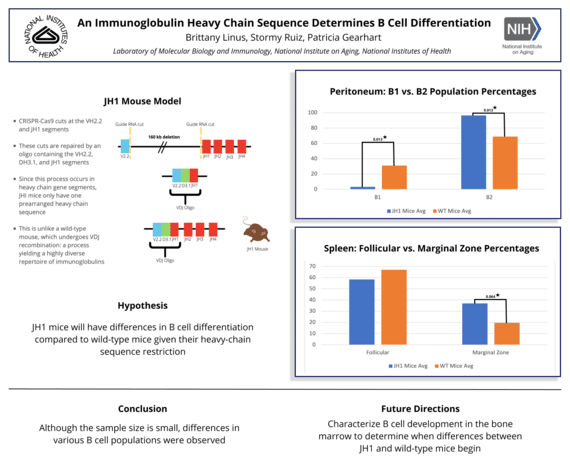
[project name:] An Immunoglobulin Heavy Chain Sequence Determines B Cell Differentiation
[link:] Here
[timeframe:] Jun — Aug 2021
[created using:] Figma
[project description:] As a research assistant for the National Institute on Aging, I was selected to present a lightning talk on our immunology research conducted in collaboration with the Gearhart Lab. Our focus lies on exploring how B cell differentiation differs between wild-type and JH1 mice——lab altered mice used in various studies in the Gearhart lab.
[reflection:] Although my career trajectory has shifted away from medicine and biomedical research, my experiences in these fields have underscored the significance of visual storytelling in data interpretation. Through my involvement, I've come to recognize the power of visualizations in elucidating complex concepts and facilitating understanding. In particular, I've focused on elucidating the disparities between wild-type and JH1 mice, leveraging visual tools such as vertical bar plots to highlight variations in B cell differentiation populations. These visual representations serve as compelling prompts for viewers to delve into the underlying causes driving these differences. Our research endeavors aim to unravel the implications of CRISPR and gene editing in the realm of immunology. By meticulously studying the effects on JH1 mice, we aspire to establish a foundational understanding that can guide future investigations. This groundwork not only elucidates potential adverse outcomes but also lays the groundwork for mitigating such risks and advancing the field responsibly.
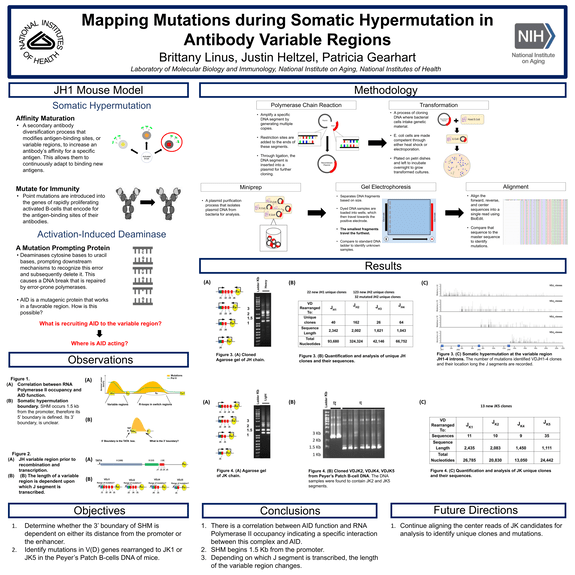
[project name:] Mapping Mutations During Somatic Hypermutation in Antibody Variable Regions
[link:] Here
[timeframe:] Jun — Sep 2019
[created using:] Google Slides
[project description:] Under the mentorship of Dr. Justin Heltzel and Principal Investigator Patricia Gearhart, I created a poster day presentation for my research on the localized activity of Activation-Induced Deaminase and its connection with RNA Polymerase II. I represented the Antibody Diversity section for the Laboratory of Molecular Biology and Immunology at the NIH Office of Intramural Training and Education where I received the Barbara. A. Hughes Award of Excellence for my contribution to ongoing research, creation of a poster presentation, and outstanding presentation of my research.
[reflection:] This poster marks my debut in design during my high school years. In this reflection, I delve into the "Methodology" segment, emphasizing its role in elucidating the intricate processes involved in acquiring and studying Activation-Induced Deaminase (AID) data through visualization. Within this section, I meticulously guide my audience through the sequential procedures I employed to isolate gene samples with active AID. I visualize each step, clarifying the methodologies utilized, the specific objectives pursued, and the subsequent preparation of samples for further analysis. Notably, each visualization presented was crafted by me, lending a personal touch to the narrative. By juxtaposing my visual representations with actual data, I facilitate audience comprehension. This deliberate contrast serves to highlight the fundamental steps in the experimental process while showcasing the transformative power of visualization in simplifying complex scientific concepts. Through this focused examination of the "Methodology" section, I underscore the significance of visualization in enhancing understanding and dissemination of scientific research. My aim is to bridge the gap between intricate scientific procedures and audience comprehension, fostering a deeper appreciation for the nuances of AID data acquisition and analysis.
[previous missions:] magazine covers
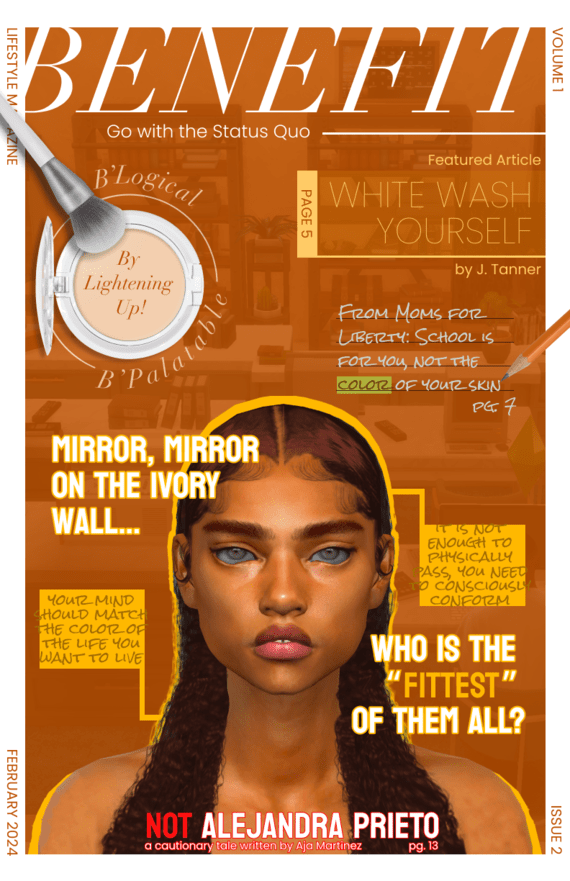
[project name:] BENEFIT: A Satirical Lifestyle Magazine
[created using:] Photoshop, Blender, & Figma
[link:] Here
[timeframe:] Jan — Mar 2024
[project description:] A satirical magazine cover serving as the first issue of a magazine. The first issue will feature a story written by Aja Martinez in her journal article, "A Plea for Critical Race Theory" that addresses "fitness" in the academy.
[reflection:] Aja Martinez, in advocating for Critical Race Theory, strengthens her argument through narration. She aims to expose how cultural insensitivity, restrictive thinking, and the standardization stifle students' talents and growth. These systems indoctrinate students into a monolithic, binary way of thinking, leaving little room for the richness of nuance. To build a counter-narrative with such impact, Martinez presents two perspectives: the dominant "stock story" and the marginalized "counterstory," amplifying the voices often silenced. Inspired by Martinez's counterstorytelling, I felt compelled to take a satirical approach to the educational contradiction. While the academe claims to support students, it often forces conformity, stripping away their unique qualities and leaving only narratives projected by dominant white culture. The target audience for this magazine is students of color who aspire to success. However, they seek more than just professional advancement; they seek lifestyle advice that enables them to not only appear successful but also embody an unrealistic ideal of "whiteness." The magazine cover will feature a juxtaposition that highlights this absurdity. One element could be an advertisement for "Lightening Makeup," a product promoting skin bleaching. The other element could be a quote from "Moms for Liberty," emphasizing their desire to sanitize and remove cultural and racial nuance from classrooms.
[previous missions:] short films
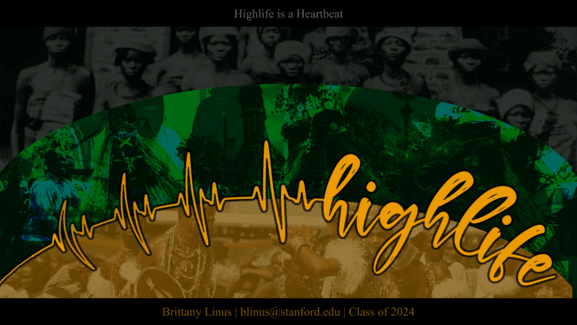
[project name:] Highlife is a Heartbeat
[timeframe:] Oct 2023 — Apr 2024
[created using:] Figma, Adobe Premiere Pro,
[link:] Here
[project description:] A kaleidoscope project that unfolds as a video montage revealing fragmented mosaics of visual and auditory expressions of Highlife starting in the Jamaican context and ending in the Nigerian context. As a philosophy, Highlife transcends genre, including geopolitical borders, because it speaks the universal language of expression, and nothing comes close to color, visual art, dance, dress, and performance in this regard. Compositionally, the cultural linkage between Jamaica and Nigeria manifest as a fusion of clips stitched together, overlapping, or quickly moving from one distinct sound to the next. The migration from Jamaica to Nigeria signifies that recalling I felt visiting Kingston—the familiarity of Highlife.
[reflection:] October of 2023 I was invited to attend the 7th Biennial Rex Nettleford Arts Conference at Edna Manley College for Visual and Performing Arts—the nexus of culture, creativity, and self-determination in Kingston, Jamaica. While there, I expanded my understanding of a word I thought I knew well, but hadn't fully understood: "Highlife." Originally, I knew highlife as being only as a musical genre, characterized by Black American jazz melodies manifesting as guitar solos fused with West African percussive traditions. Yet, my eyes bore witness to what Highlife culture looked like. Highlife transcends the boundaries of a measure full of rhythmic beats to exalt aliveness by celebrating what it means to live by stimulating the senses——eating food, listening to music, dancing, or watching others do all those things. Highlife is about choosing to live above one’s circumstances and there is no better example than Trenchtown. Through the intertwining of footage captured during my sojourns, from the vibrant streets of Kingston, Jamaica, to the ceremonial splendor of Nigerian Igbo culture around the world, this project endeavors to showcase the diasporic connections within Highlife's cultural fabric. Fragmented visual observations spotlight celebratory elements—dance, vibrancy, dynamism, color, smiles, and pampering—as the video’s thematic throughline. Together, they articulate Highlife as a diasporic heartbeat: an exuberant celebration of aliveness through the deliberate choice to live fully.